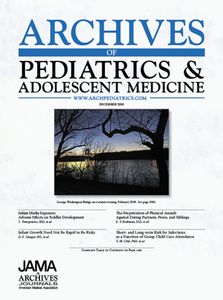Dating Violence Among Young People
Adolescents who hit or punch a sibling or peer are more likely to do the same to a dating partner than nonviolent teens. This is the disturbing finding of a new study led by researchers at the BU School of Public Health.

The study, published in the December issue of Archives of Pediatrics and Adolescent Medicine and released online yesterday, is the first to directly link sibling, peer, and dating physical violence in a representative sample of high school students, according to lead author Emily Rothman, an SPH associate professor of community health sciences.
“If someone is hitting a sister or brother or getting into fistfights at school, the odds that they will use force with a dating or sexual partner are high, particularly if they are male,” she says. “Adults need to intervene early when they become aware that a teen is using violence.”
Rothman and colleagues surveyed 1,398 high school students at 22 public high schools in Boston between January and April 2008. Of those who were violent with siblings, 29 percent were also violent with dating partners, and of those who were violent with peers, 27 percent were also violent with dating partners.
The research team found that overall, 18.7 percent of students reported having used physical violence against a dating partner in the previous month. Specifically, 9.9 percent reported hitting, punching, kicking, or choking their partner; 17.6 percent pushed, shoved, or slapped him or her; and 42.8 percent swore, cursed at, or called their partner fat, ugly, stupid, or some other insult.
Experiencing physical dating abuse can result in injury, death, and mental health problems, including suicidal thoughts, substance use, disordered eating, and depression. As many as 10 percent of U.S. high school students report having been hit, slapped, or physically hurt on purpose by their boyfriend or girlfriend in the past year, according to the authors.
One of the study’s most important lessons, Rothman says, is that “medical professionals, teachers, parents, and adolescents themselves need to be aware that a high percentage of high school students who use violence in one context are likely to use it in another.”
This study used data from the Boston Youth Survey, a locally representative sample of Boston high school students. The students were asked not only about their use of physical violence against siblings, peers, and partners, but about emotional abuse as well, such as having yelling arguments or cursing at or insulting the other person. More than half reported using emotional abuse in the past month.
The survey question about dating violence specified that by “dating,” the researchers meant a “boyfriend or girlfriend, or someone who you were romantically or sexually involved with” and that violence did not refer to playing or joking around. The researchers could thus feel confident that the physical dating violence reported was for a variety of romantic and sexual partnerships, since not all youth use the term “dating” or go out on actual dates, and that the violence reported did not reflect horseplay or innocent roughhousing.
The authors urge health care providers and families to be aware that those who are violent with siblings and peers are at greater risk of being violent with a dating partner, and that the problem should be addressed before it becomes entrenched.
“Our study documents that physical violence against dating partners is widespread,” says coauthor Renee Johnson, an SPH assistant professor of community health sciences. “This is a major public health problem that needs to be addressed.”
Besides Rothman and Johnson, the study’s coauthors are Janice Weinberg, an SPH associate professor of biostatistics, Deborah Azrael, a Harvard School of Public Health research associate of health policy and management, and Diane Hall, a behavioral scientist at the Centers for Disease Control and Prevention.
The study was supported in part by grants from the Centers for Disease Control and Prevention, the National Institute on Alcoholism and Alcohol Abuse, the National Institute on Drug Abuse, and the Robert Wood Johnson Foundation New Connections program.
This BU Today story was written by Elana Zak. She can be reached at ezak@bu.edu.